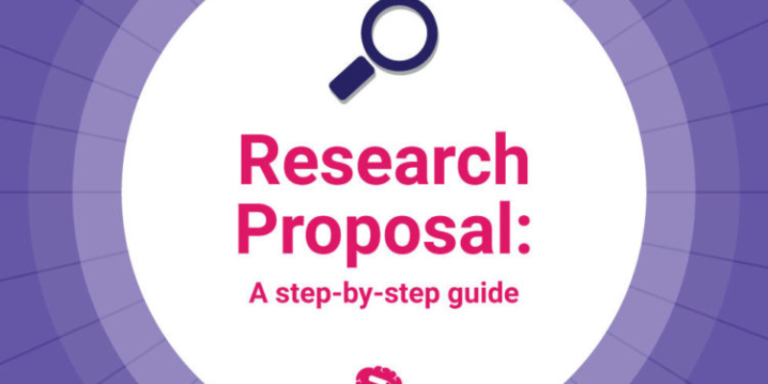A well-structured research proposal is crucial to outlining your research aim, objectives, methods, and methodologies. Follow the guideline below to structure your research proposal effectively, ensuring each section is detailed and clear.
First Page: Cover Page
The cover page of your research proposal should include the following details:
- Institution Name
The name of the university or academic institution you are enrolled in. - Programme Name
The specific programme or course for which the proposal is being submitted. - Module/Unit Code and Name
The specific module or unit the proposal is related to (e.g., BMP6005 Research Methods). - Title of the Research Topic
Provide the tentative title of your research proposal. It should be concise and reflect the research focus. - Learner Name
Your full name as the learner/researcher. - Date
The submission date of the proposal.
Second Page: Table of Contents
The table of contents should include page numbers for all chapters and sub-sections of the proposal. An example is provided below:
| Chapter/Section | Page Number(s) |
| Chapter 1: Introduction | 1 – 4 |
| 1.1 Background to Research Topic | 1 |
| 1.2 Background to Research Organisation | 2 |
| 1.4 Research Aim | 3 |
| 1.5 Research Objectives | 4 |
| Chapter 2: Research Methodology | 5 – 12 |
| 2.1 Research Philosophy/Paradigm | 5 |
| 2.2 Research Design | 6 |
| 2.3 Research Approach | 7 |
| 2.4 Research Method/Strategy | 8 |
| 2.5 Research Methodology | 9 |
| 2.6 Research Technique/Tool | 10 |
| 2.7 Sampling Approach | 11 |
| 2.8 Ethical Considerations | 12 |
| Chapter 3: Literature Review | 13 |
| Chapter 4: Timescale | 15 |
| References | 17 |
Third Page Onward: Now cover each item precisely from the table of contents.
Chapter 1: Introduction
1.1 Background to Research Topic
Provide a clear description of the topic. Explain its importance, relevance, and any key issues or trends that make it worth investigating.
1.2 Background to Research Organisation
If your research focuses on a specific organisation, briefly introduce the organisation here. Incilude its key characteristics and why it is relevant to the study.
1.3 Research Aim
State the overall aim of your research in one or two sentences. This is the broad goal that your study seeks to achieve.
1.4 Research Objectives
List specific, measurable objectives that will guide your research towards achieving the research aim. These objectives should be concise and outline the steps you will take.
Chapter 2: Research Methodology
2.1 Research Philosophy/Paradigm
Choose between Positivism or Interpretivism:
- Positivism focuses on objective, measurable data (common in quantitative research).
- Interpretivism is concerned with understanding subjective experiences (common in qualitative research).
2.2 Research Design
Choose between Explanatory or Exploratory:
- Explanatory design tests theories or relationships between variables.
- Exploratory design is used when the problem is not well-defined, allowing for more flexible investigation.
2.3 Research Approach
Choose between Deductive or Inductive:
- Deductive approach tests existing theories by applying them to data.
- Inductive approach develops new theories based on data collection and analysis.
2.4 Research Method/ Strategy
Choose between Surveys or Grounded Theory:
- Surveys collect quantitative data from large populations through questionnaires, offering broad insights into trends and patterns.
- Grounded Theory is a qualitative methodology that develops theories inductively from systematically gathered data.
Will your study involve a case study method within surveys or grounded theory, and why is it suitable?
2.5 Research Methodology
Choose between Quantitative or Qualitative:
- Quantitative research involves numerical data and statistical analysis.
- Qualitative research involves non-numerical data and is often used to understand experiences or opinions.
2.6 Research Technique/Tool
Specify the data collection technique you will use:
- Questionnaires are used for collecting quantitative data from a large number of respondents.
- Interviews provide in-depth qualitative datafrom individuals, allowing for exploration of complex issues.
Explain why your chosen method is appropriate for your research.
2.7 Sampling Approach
Choose between Probability or Non-probability sampling:
- Probability sampling uses random selection, giving each participant an equal chance of being chosen.
- Non-probability sampling selects participants based on specific criteria.
Explain your sampling method, the sample size, and why it is appropriate for your study.
2.8 Ethical Considerations
Identify key ethical issues, such as consent, confidentiality, and data protection. Explain how these issues will be addressed to ensure the ethical conduct of your research.
Chapter 3: Literature Review
While a full literature review is not required for the proposal, this section should identify key sources that will be reviewed in the dissertation. Some institutions may require a small literature review (500–1000 words) in the proposal itself. If required, outline the key theories, concepts, and sources you intend to review, and discuss their relevance to your research.
Chapter 4: Timescale/ Timeframe/ Timeline
Create a timescale outlining the key stages of your research from start to completion. Be realistic with deadlines and include milestones such as:
| Task | Timescale |
| Initial Research and Writing Introduction Chapter | Weeks 1-3 |
| Literature Review | Weeks 4-6 |
| Data Collection | Weeks 7-9 |
| Data Analysis | Weeks 10-11 |
| Final Draft Writing | Weeks 12-14 |
| Final Submission | Week 15 |
This will provide a clear view of how you plan to manage your time and resources during the research process.
References
Include a reference list with all sources cited in your proposal. Ensure that the list follows a consistent citation & reference style, such as, Harvard depending on your institution’s requirements. Cite and refer to textbooks, journal articles, and reputable websites where relevant.
By following this structure, you can develop a well-organised and effective research proposal. Be sure to tailor each section to the specifics of your research topic and methodology and consult with your supervisor to ensure you meet all institutional requirements.
Top Tips:
The table below provides a clear and concise reference for how the methodology aligns with the philosophical and design choices for the study:
| Research Philosophy | Research Design | Research Approach | Research Method/ Strategy | Research Methodology | Data Collection Technique |
| Positivism | Explanatory | Deductive | Surveys | Quantitative | Questionnaires |
| Interpretivism | Exploratory | Inductive | Grounded Theory | Qualitative | Interviews |









